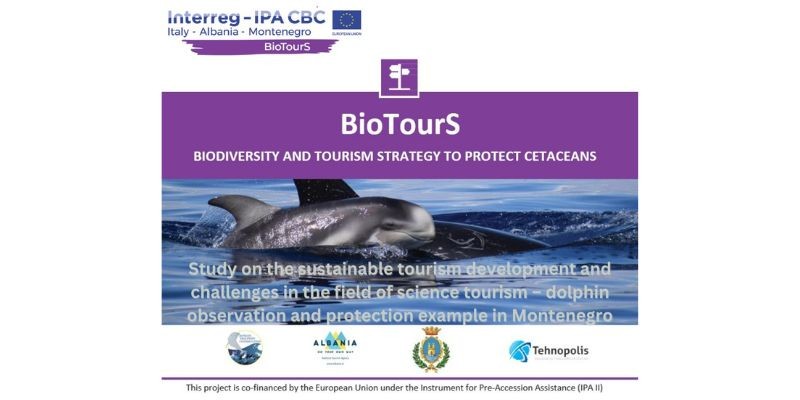
Innovation and Entrepreneurship Centre Tehnopolis, as a project partner within the BioTourS project created the “Study on the sustainable tourism development and challenges in the field of science tourism – Dolphin observation and protection example in Montenegro”, with the aim to present the possibilities of developing sustainable tourism in the field of dolphin observation and conservation in Montenegro. The conducted research includes data on sustainable tourism, biodiversity, dolphin conservation methodologies, challenges and recommendations for the future. The geographical area which is in focus of this study is Boka Kotorska Bay, and it refers to science tourism development based on dolphin observation, including good practice examples in dolphin conservation and sustainability.
Research presented in this study shows the high value of biodiversity for tourism. Biodiversity is a vital component of the environmental quality and attraction of destinations for tourists and needs to be protected for the long-term success of tourism.
Through many research works, Boka Kotorska Bay has been recognized as a natural habitat for marine mammals, including dolphins. In total, 699 surveys (2339:20 hours) were carried out between the 15th of September 2016 and 26th of April 2021. Overall, 403 focal groups were encountered in 241 days of survey effort, during which two species were recorded: Bottlenose dolphins (Tursiops truncatus) and striped dolphins (Stenella coeruleoalba). While bottlenose dolphins formed the highest sighted species being responsible for 95% of the sighting's, striped dolphins were only encountered on 20 occasions.
Data collected within this study contributes to a better understanding of the biology and ecology of the local bottlenose dolphin community, using the marine area of Boka Kotorska, thereby contributing to 49 proactive monitoring and assessing the status of the population in the future. re. In order to ensure the above mentioned, following measures should be implemented:
-
continued monitoring and research activities within the area of Boka Kotorska Bay in order to determine trends in population abundance (rise, fall, stagnation) and to get a more complete dataset on the home range and changes in the distribution of individuals that can be the result of anthropogenic disturbance;
-
collecting further data on the relevant habitat characteristics and the distribution of bottlenose dolphins in the research area to perform an analysis of habitat use and to identify critical habitats/areas;
-
It is necessary to continue to collect detailed information about the types and extent of anthropogenic activities in the research area as well as its spatial distribution that will help identify and re-evaluate areas where the population is under the greatest real or potential pressure;
-
It is necessary to monitor fishing stock and the impact of particular fishing tools on the availability of prey to bottlenose dolphins and in particular, determine the extent of use of fishing tools specifically interacting with bottlenose dolphins.
Considering that there is evidence to suggest that the bottlenose dolphin population is declining in Montenegro and the cause of this is unclear, further research and the precautionary approach with the help of citizen science is needed and recommended.
The entire study is available at the link: BioTourS Study about sustainable tourism and new challenges.pdf
